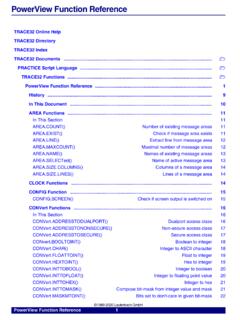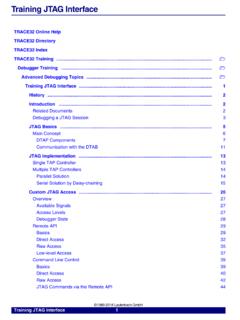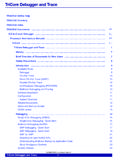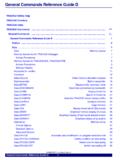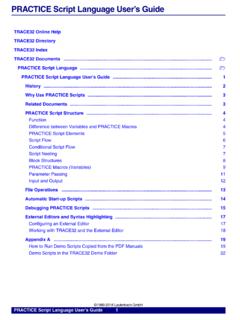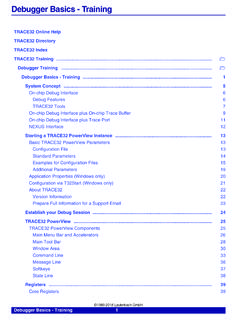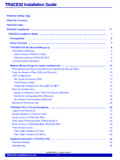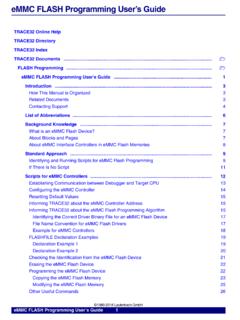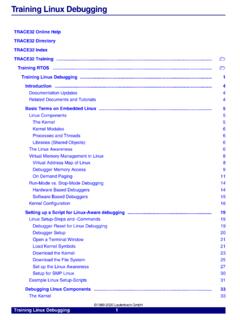Transcription of General Commands Reference Guide V - Lauterbach
1 General Commands Reference Guide V. Release MANUAL. General Commands Reference Guide V. trace32 Online help trace32 Directory trace32 Index trace32 Documents .. General Commands .. General Commands Reference Guide V .. 1. History .. 5. Var .. 6. Var HLL variables and expressions 6. Overview Var 6. Symbol Prefix and Postfix 6. Symbol Paths 7. Search Paths 7. Mangled Names and C++ Classes 8. Function Return Values 8. Special Expressions 8. Calling Functions 11. Display Formats 12. Functions 23. Add variable sticker to source listing window 23. Add variable to window 24. Add variables to window using wildcards 24. Assignment to a variable 25. Breakpoint on variable 26. Delete breakpoint on variable 26. Set temporary breakpoint on HLL expression 28. Define pass condition for breakpoint 29. Set breakpoint to HLL expression 30. Call a new procedure 31. Display linked list 32.
2 Delete variable from watch 33. Graphical variable display 33. Graphical variable display 37. Memory dump 38. Evaluate high-level expression 39. Export variables in CSV format to file 39. Display linked list 41. 1989-2021 Lauterbach GmbH General Commands Reference Guide V | 2. Display table 41. Real-time emulation 43. Re-run program backwards until variable access (CTS) 43. Real-time emulation till expression changes 44. Real-time emulation with breakpoint 45. Real-time emulation till expression true 46. PRACTICE conditional branching 47. View information about HLL variable or HLL expression 48. Local variables 49. Log variables 50. Creates a trace32 -internal variable 52. Creates a global trace32 -internal variable 53. Creates a local trace32 -internal variable 54. Pretty printing for C++ objects 56. Display variables allowing wildcards for symbol name and type 58.
3 Display variables 59. Graphical display of variable 60. Referenced variables 61. Modify variable 62. Step 65. Step back till expression changes 65. Step back till expression true 65. Step till expression changes 66. Step till expression true 66. Display table 67. Display variables in the form of a tree structure 68. Display variable types 69. Display variables 70. Open window 72. PRACTICE loop construction 73. Write variables to file 74. VCO .. 75. VCO Clock generator 75. Control bus clock 75. Frequency down 75. Control VCO clock 76. VCO rate 76. VCO reset 77. State display 77. Set the time base clock 77. Frequency up 78. VCU .. 79. VCU VCU registers (Vector Computational Unit) 79. 1989-2021 Lauterbach GmbH General Commands Reference Guide V | 3. Initialize VCU registers 79. Reset VCU registers 79. Set VCU register 80. Display VCU registers 80. VE .. 81.
4 VE Virtual execution mode 81. Turn off virtual execution mode 81. Turn on virtual execution mode 81. VPU .. 82. VPU Vector Processing Unit (VPU) 82. Initialize ALTIVEC registers 82. Modify ALTIVEC registers 82. Display ALTIVEC register window 83. 1989-2021 Lauterbach GmbH General Commands Reference Guide V | 4. General Commands Reference Guide V. Version 04-Nov-2021. History 08-May-20 Description for command 1989-2021 Lauterbach GmbH General Commands Reference Guide V | 5. Var Var HLL variables and expressions See also (). () () () (). () (). 'Var Functions' in ' General Function Reference '. 'Release Information' in 'Release History'. Overview Var Lower and upper case letters are distinguished in symbol names. The command switches off this differentiation. The length of symbol names is limited to 255 characters. The maximum number of symbols depends on the size of the system memory.
5 Symbol Prefix and Postfix Most of the compilers add a special character (for example . or _ ) in front of or behind the users symbol names. The user does not need to enter this character. The symbol management automatically adds the character, if necessary. Example for the processing of prefix/postfix characters. Symbol Table Entry HLL-Windows Assembler windows _vfloat _vfloat or vfloat _vfloat vfloat 1989-2021 Lauterbach GmbH General Commands Reference Guide V | 6. Symbol Paths There are two modes during entry a symbol name: entering a complete symbol path or solely a symbol name. If only a symbol name is used, the access will occur to the symbol valid for the used program part (if symbol names are used more than once, local symbols are preferred to symbols of higher blocks). By specifying a complete symbol path access to any symbol is possible. Each part of the symbol path is separated by a '\'.
6 A complete path has to begin with a '\'. The following path versions are allowed: \modul\global . \modul\modul-local . \\program\modul . If the specified symbol represents a function, the access to local variables of this function and of nested functions will be possible: \function\local \function\function . If using PASCAL, as many functions as chosen will be nested. Line numbers can be specified in the following way: \linenumber \linenumber\columnnumber \module\linenumber \\program\module\linenumber ..\function\relative_linenumber The address of the high level language block containing the specified line number is returned by this operation. Search Paths If no complete path is entered, the symbol will be searched in the following sequence 1. Local symbols (interior block exterior block). 2. Static symbols of block 3. Static symbols of module 4. Global symbols of current program 5.
7 All other static symbols 1989-2021 Lauterbach GmbH General Commands Reference Guide V | 7. Mangled Names and C++ Classes The class of a method can be left out, if this method exists only in one class and the names are ANSI. mangled. The class is always required, if the constructor, destructor or an overloaded operator must be accessed. The quotation marks can help to allow special characters if the C++ name is used in the regular trace32 syntax. They are not required in the Var command group. However they can be used when specifying a local symbol. The command can control the behavior if an overloaded method is not specified with the prototype. List `class1::method1`. List method1 //access to same method (ANSI. // mangled). List `class1::class1` //creator of class class1. List `class1::~class1` //destructor of class class1. List `class1::operator++` //overloaded operator List `class1::operator+(int)` //overloaded operator with // prototype `class1::operator+(int)\i` //local variable of function Function Return Values The return value of a function is entered in the symbol list as a local variable of the function.
8 It has always the name 'return'. Special Expressions The expression interpreter accept some extensions to the language. All type checks and range checks are handled as free as possible. Accessing data beyond the array limits is allowed. A dereference of a plain number will assume that it is a pointer to character: *0x2000 = 1 //set byte at location 2000 (decimal). All labels (typeless symbols) can be used in expressions. They are taken as variables of the type void. They can be cast directly to the wanted type. __HEAP //displays nothing (if __HEAP is a label). *__HEAP //assumes __HEAP as a pointer to character (long)__HEAP //takes __HEAP as a 'long' variable 1989-2021 Lauterbach GmbH General Commands Reference Guide V | 8. Function calls can be made to plain addresses or typeless symbols. The return value is assumed to be 'void'. (0x2000)(1,2,3) //calls the function at 2000 (hex).
9 __HEAP(1,2,3) //calls the function at the label __HEAP. Extracts of arrays can be made with 'range' expressions. The operations allowed with such extracts is limited. This allows display of zero sized arrays and display of pointers to arrays. flags[ ] //display elements 2 to 4. vdblarray[ ][ +1] //display part of two-dimensional //array vpchar[ ] //display array at pointer 'vpchar'. (&vchar)[ ] //takes the location of one element //to build up an array vpchar[ ][ ] //display a two dimensional array //at the pointer Extracts of arrays can be assigned or compared to members of the array. flags[ ]=0 //clears the array to 0. flags[ ]==0 //results a non-zero number if all //elements are 0. Assigning strings can cause two different reactions. If the string is assigned to a NULL pointer, the target function 'malloc' is called to gather memory for the string and the resulting address is assigned to the pointer variable.
10 If the string is assigned to a non zero pointer or an array, then the contents of the string are copied over the old contents of the array. vpchar = 0. vpchar = "abc" //will call the 'malloc' function vpchar = 0x100. vpchar = "abc" //copy the string "abc" to location 0x100. Comparing a pointer or array against a string compares the contents of the string. pname=="TEST" //execute program till string equal Strings used in arguments to functions are allocated on the stack. strlen("abc") //the string will reside on the stack 1989-2021 Lauterbach GmbH General Commands Reference Guide V | 9. A type alone can be an expression. This is especially useful for the command to display the layout of a structure or C++ class. %Multiline Tree //displays the layout of class 'Tree'. Elements of unions can be accessed by indexing the union like an array. The first element of the union is accessed with index 0.
